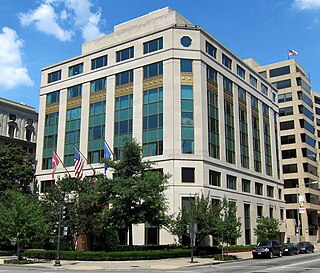Related Research Articles

The American Federation of Labor (AFL) was a national federation of labor unions in the United States founded in Columbus, Ohio, in December 1886 by an alliance of craft unions disaffected from the Knights of Labor, a national labor union. Samuel Gompers was elected the full-time president at its founding convention and reelected every year, except one, until his death in 1924. He became the major spokesperson for the union movement.
The United Food and Commercial Workers International Union (UFCW) is a labor union representing approximately 1.3 million workers in the United States and Canada in industries including retail; meatpacking, food processing and manufacturing; hospitality; agriculture; cannabis; chemical trades; security; textile, and health care. UFCW is affiliated with the Canadian Labour Congress (CLC) and the AFL–CIO; it disaffiliated from the AFL–CIO in 2005 but reaffiliated in 2013. UFCW is also affiliated to UNI Global Union and the IUF.

The National Education Association (NEA) is the largest labor union and the largest white-collar representative in the United States. It represents public school teachers and other support personnel, faculty and staffers at colleges and universities, retired educators, and college students preparing to become teachers. The NEA has just under 3 million members and is headquartered in Washington, D.C. The NEA had a budget of more than $341 million for the 2012–2013 fiscal year. Becky Pringle is the NEA's current president.

The Laborers' International Union of North America (LIUNA), often shortened to just the Laborers' Union, is an American and Canadian labor union formed in 1903. As of 2017, they had about 500,000 members, about 80,000 of whom are in Canada. The current general president is Terence M. O'Sullivan who was appointed general president in 2000, elected by delegates in 2001, and re-elected in 2006. There are nine regions across North America; these regions are further divided into 500 local unions. One region is in Toronto Canada and is led by Joseph Mancinelli, Local 183, which is the largest construction local union in North America.
The International Typographical Union (ITU) was a US trade union for the printing trade for newspapers and other media. It was founded on May 3, 1852, in the United States as the National Typographical Union, and changed its name to the International Typographical Union at its Albany, New York, convention in 1869 after it began organizing members in Canada. The ITU was one of the first unions to admit female members, admitting women members such as Augusta Lewis, Mary Moore and Eva Howard in 1869.

James Duncan was a Scottish American union leader, and president of the Granite Cutters' International Association from 1885 until his death in 1928. He was an influential member of the American labor movement, helping to co-found the American Federation of Labor.

The Glass, Molders, Pottery, Plastics and Allied Workers International Union is a labor union which represents about 28,000 craft and industrial workers primarily in the ceramics, china, craft metals, fiberglass, glass, insulation, and pottery industries. It is one of the oldest unions in the United States, with its first locals formed in 1842.
The American Federation of Hosiery Workers (AFHW) was a labor union representing workers involved in manufacturing hosiery.
The United Shoe Workers of America (USWA) was a trade union representing workers involved in making shoes and other leather goods.
The Cloth Hat, Cap and Millinery Workers International Union (CHCMW) was a trade union representing workers involved in making headwear in the United States and Canada.
The International Glove Workers' Union of America (IGWUA) was a labor union representing workers involved in making gloves in the United States and Canada.
The Amalgamated Lace Operatives of America (ALOA) was a labor union representing workers involved in making items out of lace.
The International Spinners' Union (ISU) was a labor union representing cotton spinners in the United States.
The Shoe Workers' Protective Union (SWPU) was a trade union representing workers involved in making footwear in the United States.
The International Stereotypers' and Electrotypers' Union (ISEU) was a labor union representing workers in two related trades in the United States and Canada.
The International Printing Pressmen and Assistants' Union of North America (IPPU) was a labor union representing printing workers in the United States and Canada.
The Lithographers' and Photoengravers' International Union (LPIU) was a labor union representing printing workers in the United States and Canada.
The International Brotherhood of Bookbinders (IBB) was a labor union representing bookbinding workers in the United States and Canada.
The International Brotherhood of Pulp, Sulphite, and Paper Mill Workers (IBPSPMW) was a labor union representing workers involved in making paper in the United States and Canada.
References
- 1 2 3 "Inactive Organizations" (PDF). UMD Labor Collections. University of Maryland. Retrieved 18 April 2022.
- ↑ Handbook of American Trade Unions (PDF). Washington DC: United States Department of Labor. 1926. Retrieved 24 April 2022.
- ↑ Directory of National and International Labor Unions in the United States (PDF). Washington DC: United States Department of Labor. 1957. Retrieved 18 April 2022.